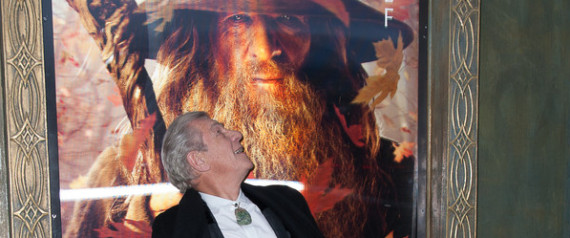The world just sucks sometimes.
Contemporary pop culture is full of both lies and truths that are hard to accept. The way you've come to think about "greats" like John Wayne and even the animated star of Pokémon is probably all wrong. And sorry, but Twinkies simply aren't the everlasting dessert you hoped them to be. This is all probably a lot to handle, but we're confident you can make your way through the following 19 truths...
You're going to be pretty mad after this.  1. Michael J. Fox's middle name doesn't start with a "J."
1. Michael J. Fox's middle name doesn't start with a "J." 
Fox's middle name is Andrew.
As there was
already a registered Michael Fox in the Screen Actors Guild, the future "Back To The Future" star had to register another name. He considered going by his actual middle name, but instead decided to put down "Michael J. Fox" as a tribute to actor
Michael J. Pollard.
2. Twinkies do not have an infinite shelf life. 
The Hostess treat doesn't last
forever and has a
shelf-life of about 45 days. This is actually an improvement on the recipe that existed before the recent
Twinkiepocalypse, which gave us treats that last longer than the previous shelf life of about 26 days.
And if you'd rather eat something that you wouldn't believe could last forever anyway, here's a recipe for
homemade Twinkies.
3. The author of the "Nancy Drew" series was completely made up. 
Carolyn Keene is not a real person and is
actually a pseudonym for many different authors.
The
writer and publisher, Edward Stratemeyer, hired ghost writers to take all of his detective-fiction ideas for the Nancy Drew series and turn them into full books. The first ghost writer was named Mildred Wirt Benson and she is the real author of "The Secret of the Old Clock," along with the next two books. She was only 24 at the time. As all writers had to sign confidentiality agreements about the fact that Carolyn Keene wasn't a real person, Benson's name has been largely lost in popular history.
4. Nicolas Cage got paid $20 million to play Superman ... even though he never actually did. 
Tim Burton almost got to direct a version of Superman
starring Nicolas Cage. Costume test photos
even exist.
This version would have been called "Superman Lives," and Cage has been quoted as saying, "Did I have a concept of how to play the character? Yes, and I can tell you it would have been gutsy. So maybe Warner Brothers got scared because they had two artists that weren’t afraid to take chances."
Would this movie have been good or terrible? That may be an
unsolvable question.
5. "The Great Cat Massacre" is actually a real event that exists in history. 
French apprentice printers in the
late 1730s came to hate how much better the French aristocracy treated their cats over the workers, leading primped felines to become symbols of classist oppression. In a display of opposition that may have killed the Internet in contemporary times, French workers began kidnapping cats to slice them open and hang them by nooses in the streets.
According to the book "
The Great Cat Massacre: And Other Episodes in French Cultural History," the whole thing was considered deeply hilarious and an early moment of triumph for the French working class.
6. President Richard Nixon hated Bill Cosby and allegedly had the FBI wiretap him. 
Camille Cosby, Bill Cosby's wife since 1964, revealed to Oprah that
her family was audited four times in one year, had their phones wiretapped and were subjected to FBI visits at their house and on set. All of this was because Bill Cosby was put on Nixon's famed "
Enemies List," along with
celebrities such as Paul Newman and Barbra Streisand.
7. The actors that played C-3PO and R2-D2 hate each other very much. 
Kenny Baker (R2-D2) does not remember his days with actor Anthony Daniels (C-3PO) fondly at all and has
even said that Daniels is "the rudest man I've ever met."
In a longer quote,
Baker explained, "He's been such an awkward person over the years. If he just calmed down and socialized with everyone, we could make a fortune touring around making personal appearances. I've asked him four times now but, the last time, he looked down his nose at me like I was a piece of s***. He said: 'I don't do many of these conventions - go away little man.' He really degraded me and made me feel small - for want of a better expression."
8. Subway once released an official statement saying that "footlong" is a trademarked name and not an obligation of the length of a sandwich. 
After being
sued multiple times over their popular "$5 Footlongs" not always being an actual a foot long, despite advertising that was pretty
explicit about the size, the company had the nerve to make the
following statement ...
"With regards to the size of the bread and calling it a footlong, "SUBWAY FOOTLONG" is a registered trademark as a descriptive name for the sub sold in Subway Restaurants and not intended to be a measurement of length."
Early in 2013, the company claimed they'd ensure all
future "Footlongs" would truly be a foot long.
9. Filming of "The Hobbit" disappointed Sir Ian McKellen so much that it made him cry. 
When McKellen had to film a scene featuring his character, Gandalf, standing among a large group of dwarves, the studio wouldn't let him film with the other actors and instead surrounded him with pictures of the dwarves. McKellen said that he began to
break down and cry, accidentally saying into his live microphone, "This is not why I became an actor."
Nowadays the actor seems to be having quite a
bit more fun performing alongside his
friend Sir Patrick Stewart in
two Broadway plays.
10. The creator of the famous Loch Ness Monster picture admitted it was a hoax on his deathbed decades later. 
At the age of 93,
Christian Spurling confessed from his deathbed that "The Surgeon's Photo" of the Loch Ness Monster was a complete hoax masterminded by his stepfather, Marmaduke Wetherell.
You see,
Wetherell was employed by The Daily Mail and had an assignment to report on the Loch Ness sightings. When the paper published that his only findings ("monster" tracks) were a hoax and that he'd been fooled, Wetherell decided to get back at the paper. He enlisted his stepson, Spurling, who was a professional model maker, to create a fake monster head and then took a picture of the head floating in Loch Ness. The two hired "the surgeon," gynecologist Robert Wilson, to turn the photo into the newspaper to add legitimacy to the hoax.
Just last year, The Daily Mail published
another photograph of the Loch Ness Monster, but then again, so did
HuffPost.
11. John Wayne felt the Native Americans deserved their mistreatment and were selfish for wanting to keep the land. 
Just
read this Playboy interview...
PLAYBOY: That's hardly the point, but let's change the subject. For years American Indians have played an important—if subordinate—role in your Westerns. Do you feel any empathy with them?
WAYNE: I don't feel we did wrong in taking this great country away from them, if that's what you're asking. Our so-called stealing of this country from them was just a matter of survival. There were great numbers of people who needed new land, and the Indians were selfishly trying to keep it for themselves.
Also, Wayne's scenes apparently had to be filmed in the morning,
because in the afternoon he was a "mean drunk."
12. Multiple "Marlboro Men" have died from lung cancer. 
Throughout the late 1970s, Eric Lawson played the
iconic "Marlboro Man", serving as the centerpiece of various ads depicting him as a rugged, smoking cowboy. On Jan. 10th, Lawson
died of lung cancer, the same cause of death that multiple Marlboro men before him have succumbed to.
Smoking is
estimated to be responsible for around 443,000 deaths per year in the U.S. alone.
13. Ash Ketchum is actually a pathetic Pokémon trainer. 
Ketchum has only caught 43 of 649 Pokémon and has never made it past the tournament semi-finals in his 14-year quest to become a Pokémon Master. This means
Ketchum actually
hasn't even come close at all to fulfilling the cartoon series' tagline, "Gotta catch 'em all."
If you want to begin your own quest to become a Pokémon master and succeed where Ketchum utterly failed, here's a good
place to start.
14. The movie "Saving Mr. Banks" was pure Disney propaganda. The author of "Mary Poppins" deeply hated the film version of her book. 
"Saving Mr. Banks" essentially
rewrote history and poured salt on old wounds in their portrayal of "Mary Poppins" author P.L Travers as an uptight woman who just needed to learn the value of "Disney Magic." Margaret Lyons of New York Magazine has an
amazing takedown.
One of the best examples of the film's propaganda-fueled rewriting of history comes at the end of "Saving Mr. Banks," when Travers is depicted as crying tears of relief and joy because, despite her earlier reservations, the movie version of "Mary Poppins" turned out wonderful. Although it is true that Travers cried, according to the biography "Mary Poppins, She Wrote: The Life of P.L. Travers," by Valerie Lawson, those were tears of sadness and anger.
And Travers actually didn't even get an invite to the premiere. She had to force her way in to watch.
15. While you may have loved "Pride & Prejudice," Mark Twain and many other iconic writers thought it was garbage. 
The writing of Jane Austen was
despised by authors like Virginia Woolf, Ralph Waldo Emerson and Charlotte Brontë, but the most biting criticism seems to have come from Mark Twain in the quote below.
I often want to criticize Jane Austen, but her books madden me so that I can’t conceal my frenzy from the reader; and therefore I have to stop every time I begin. Every time I read Pride and Prejudice I want to dig her up and beat her over the skull with her own shin bone!
16. Vanilla Ice broke up with Madonna. 
If you didn't already know, Vanilla Ice and Madonna used to
date.
During an interview in 2011, Ice declared that the material girl was a "
great lover," but also revealed, "I broke up with her after she printed that book because I was hurt to be an unwitting part of this slutty package."
17. If "The Simpsons" aged normally, Bart would now be older than Marge was in the first season. 
Basically, this should just make you feel super old. Sorry. When the show premiered in 1989, Marge Simpson was supposed to be 34, while Bart was 10. In the show's 25 seasons, Bart would now presumably be older that Marge was when "The Simpsons" first aired.
Of course, the Simpsons family
doesn't age, but the show has given a glimpse at times of what older versions of the characters
would look like.
18. American Airlines kicked Magic Johnson off their plane so Mark Cuban could take a date to Las Vegas. 
Long before the days of his ownership of the Dallas Mavericks and starring role in "Shark Tank," Cuban bought a lifetime flight pass from American Airlines. The pass even required the airline to kick passengers off the plane in case Cuban ever showed up and wanted to get on.
In an
interview with Billy Bush, Cuban explained that he'd once tried to use the pass go to Las Vegas with a date. When he arrived and found the flight was already full, Cuban said American Airlines decided to
kick Magic Johnson off the plane.
The two would later come head-to-head in a
bidding war for the Los Angeles Dodgers in 2012, a battle that Johnson
ended up winning.
19. Nickelback lullabies exist. 
Two lullaby versions of Nickelback "classics" exist, and you
can buy both
of them on Amazon.
One five-star review reads, "This is my son's favorite band...we really dig this album and Mom's being a good sport because everyone chills out." A three-star review was upset that the lullaby artist was simply making a cash grab and wasn't being, "done by a true fan of the band being covered."
Nickelback was named the
rock band of the decade by Billboard in 2009. That should also make you very, very angry.
All images from Getty unless otherwise noted or linked to original source.from Chicago - The Huffington Post http://ift.tt/1hYkaCe
via
IFTTT